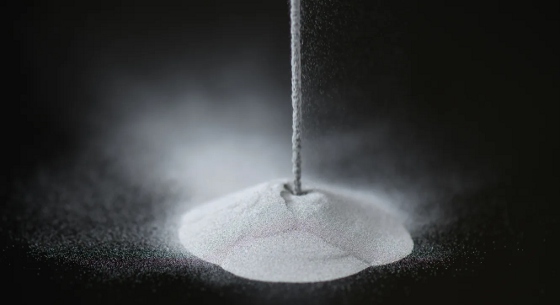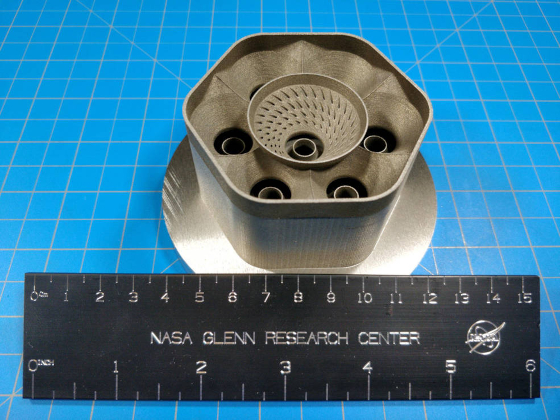 |
| May 14, 2024 | Volume 20 Issue 18 |
Designfax weekly eMagazine
Archives
Partners
Manufacturing Center
Product Spotlight
Modern Applications News
Metalworking Ideas For
Today's Job Shops
Tooling and Production
Strategies for large
metalworking plants
Companies line up to license NASA super alloy: Lasts 2,500x longer than state-of-the-art alloys

NASA super alloy GRX-810 will soon be available to aviation and space industry parts manufacturers as a result of new licensing agreements with four U.S. companies. [Credit: NASA/Jef Janis]
NASA's investment in a breakthrough super alloy developed for the extreme temperatures and harsh conditions of air and spaceflight is on the threshold of paying commercial dividends. The agency is licensing its invention, dubbed "GRX-810," to four American companies, a practice that benefits the United States economy as a return on investment of taxpayer dollars.
GRX-810 is a 3D-printable high-temperature material that will lead to stronger, more durable airplane and spacecraft parts that can withstand more punishment before reaching their breaking point.
The co-exclusive license agreements will allow the companies to produce and market GRX-810 to airplane and rocket equipment manufacturers as well as the entire supply chain. The four co-exclusive licensees are:
- Carpenter Technology Corporation of Reading, PA;
- Elementum 3D, Inc. of Erie, CO;
- Linde Advanced Material Technologies, Inc. of Indianapolis, IN; and
- Powder Alloy Corporation of Loveland, OH.
New approach to developing materials
NASA engineers designed GRX-810 for aerospace applications, including liquid rocket engine injectors, combustors, turbines, and hot-section components capable of enduring temperatures over 2,000 degrees F.
"GRX-810 represents a new alloy design space and manufacturing technique that was impossible a few years ago," said Dr. Tim Smith, materials researcher at NASA Glenn.
Smith co-invented the super alloy along with his Glenn colleague Christopher Kantzos using a time-saving computer modeling and laser 3D-printing process that fuses metals together, layer by layer. Tiny particles containing oxygen atoms spread throughout the alloy to enhance its strength.
Impacts and benefits
Compared to other nickel-base alloys, GRX-810 can endure higher temperatures and stress and can last up to 2,500 times longer. It's also nearly four times better at flexing before breaking and twice as resistant to oxidation damage.
"Adoption of this alloy will lead to more sustainable aviation and space exploration," said Dale Hopkins, deputy project manager of NASA's Transformational Tools and Technologies project. "This is because jet engine and rocket components made from GRX-810 will lower operating costs by lasting longer and improving overall fuel efficiency."
Research and development teams included those from Glenn, NASA's Ames Research Center in California's Silicon Valley, The Ohio State University, and NASA's Marshall Space Flight Center in Huntsville, AL, where the most recent testing included 3D-printed rocket engine parts.
More about the GRX-810 super alloy
NASA Alloy GRX-810, an oxide dispersion strengthened (ODS) alloy, can endure temperatures over 2,000 F, is more malleable, and can survive 2,500 times longer than existing state-of-the-art alloys (Ni-based super alloys). These new alloys (made using specially coated metal powder) can be used to build aerospace parts for high-temperature applications, like those inside aircraft and rocket engines, because ODS alloys can withstand harsher conditions before reaching their breaking point.

This turbine engine combustor (fuel-air mixer) was 3D printed at NASA Glenn in 2022 and is one example of a challenging component that can benefit from applying the new GRX-810 alloys. [Credits: NASA]
"The nanoscale oxide particles convey the incredible performance benefits of this alloy," said Dale Hopkins, deputy project manager of NASA's Transformational Tools and Technologies project in an update on the material in 2022.
It's challenging and expensive to produce ODS alloys for these extreme environments. To develop NASA Alloy GRX-810, agency researchers used computational models to determine the alloy's composition. The team then leveraged 3D printing to uniformly disperse nanoscale oxides throughout the alloy, which provides improved high-temperature properties and durable performance. This manufacturing process is more efficient, cost effective, and cleaner than conventional manufacturing methods.
[Designfax Editor's Note: What is notable is the final alloy is made while the part is being produced (3D printed). The coated powder mix comes together as the final alloy through the 3D-printing (laser powder bed fusion) process. The medium-entropy alloy is made of oxide dispersion strengthened nickel/cobalt/chromium or NiCoCr. The oxide agent is yttrium oxide or Y2O3. The final product is called ODS-NiCoCr.]
These alloys have major implications for the future of sustainable flight. For example, when used in a jet engine, the alloy's higher temperature and increased durability capability translates into reduced fuel burn and lower operating and maintenance costs.
This alloy also affords engine part designers new flexibilities like lighter materials paired with vast performance improvements. Designers can now contemplate tradeoffs they couldn't consider before, without sacrificing performance.
"This breakthrough is revolutionary for materials development. New types of stronger and more lightweight materials play a key role as NASA aims to change the future of flight," said Hopkins. "Previously, an increase in tensile strength usually lowered a material's ability to stretch and bend before breaking, which is why our new alloy is remarkable."
Webinar: Ready for a really deep dive? Learn all the fine details: NASA's additive manufacturing alloys for high-temperature applications (video run time = ~30 min.) Editor's Note: In 2022, NASA described the durability of the GRX-810 material as "can survive more than 1,000 times longer" than state-of-the-art alloys. In 2024, the description was "lasting 2,500 times longer" than state-of-the-art alloys.]
Learn about NASA's Technology Transfer Program at https://technology.nasa.gov/.
Source: Compiled from NASA reports by Brian Newbacher (NASA Glenn) and Diana Fitzgerald (NASA's Langley Research Center).
Published May 2024
Rate this article
View our terms of use and privacy policy
